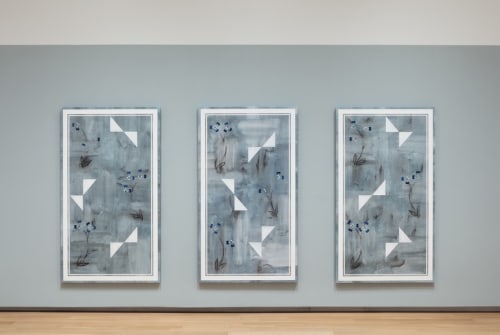
Installation view of Kamrooz Aram's Ornament for Extraordinary Architecture, 2018, oil, wax, oil crayon and pencil on canvas, 426.7 × 198.1 × 4.1 cm, at “Focus,” Modern Art Museum of Fort Worth, 2018.
Focus: Kamrooz Aram
By Paul Laster
June 5, 2018
Blurring the boundary between traditional non-Western art and Western Modernism, Iranian-American artist Kamrooz Aram mixes representational objects and imagery with abstraction, ornamentation and exhibition design to create profound paintings, collages, drawings and installations, many of which reference traditional Persian visual culture to comment on the institutional display of Islamic art objects. Aram began to consider the gallery space as an architectural whole with such recent exhibitions as “Recollections for a Room” at Dubai’s Green Art Gallery in 2016–17; “Ornament for Indifferent Architecture” at the Museum Dhondt-Dhaenens in Deurle, Belgium in 2017; and “Ancient Blue Ornament” at the Atlanta Contemporary in Atlanta, Georgia in January this year. Featuring painted walls, decorative canvases, graphic collages and sculptural tableaux, these exhibitions embraced the design concept of a Gesamtkunstwerk, or a synthesis of the arts.
These experimental presentations led directly to his striking show at the Modern Art Museum of Fort Worth, Texas, which is arguably one of his best exhibitions to date. Occupying three galleries of Tadao Ando’s dynamically designed museum, which opened in 2002, the show combines elements of Russian Suprematist paintings, Persian rugs and Islamic artifacts with traditional methods of museum presentation. Adding even more facets to this fusion, the artist employs materials that reference Venetian architect Carlo Scarpa’s sophisticated structural designs, while creating poetic assemblages that evoke the pioneering Romanian modernist Constantin Brâncuși’s heterogeneous forms.
Entering the first gallery, the visitor is confronted with Ornament for Extraordinary Architecture (2018) a triptych featuring navy and white floral patterns in oil crayon drawn on a painted field of smudged pale blue and gray patches. White triangles—referencing Modernist and Persian motifs—float on the surface, while grids rendered in fine turquoise lines on the canvases, only visible up close, further disrupt the image. Painted white mats along the edges of the canvas create trompe l’oeil frames simulating an elegant presentation on a matching bluish-gray wall.
A number of paintings visually similar to Extraordinary Architecture—Ornamental Composition for Social Spaces 16, 17 and 20—were also on view. Even though the point of departure is the floral pattern of a Persian rug, the paintings allude to the abstract canvases of the American artists Agnes Martin, through the use of the grid, and Joan Mitchell, with the smudged grounds. The trompe l’oeil framing also brings to mind the Minimalist paintings of Jo Baer, while the relationship between the shapes on the surface and the murkiness below seems to come straight out of Abstract Expressionist Hans Hofmann’s theory of push and pull, a technique used to create the illusion of space.
The second gallery, which is delineated by a thick wall painted with a red and gray geometric column at its edge, features the sculptural tableaux Green Movement (2018) and Green Memorial (2017). Green Movement is especially intriguing with its assemblage of parts—a dark green wooden pedestal is topped by a brass-framed piece of terrazzo holding a red ceramic vase, positioned off-center. Behind this is a painting of a green square, a triangular section at its bottom right corner rendered in a deeper shade, against a background of beige Belgian linen. The composition is counterbalanced by a found ceramic tile with an abstract triangular motif, mounted at the top left corner of the square. In a simpler gesture, Aram places an antique, ceramic Persian pitcher atop a small linen pedestal perched on a slab of green marble to poetically construct Green Memorial. Meanwhile, the walls of the gallery are painted with gray and red rectangles, which dynamically interact with and play off of the works on display.
The third gallery offers the sculptural tableaux Blue Backdrop for Minor Arts (2018) and Composition with Fragments (2017). While Blue Backdrop possesses the precision and complexity of Green Movement, with its midnight blue quadrilaterals and elegant chinoiserie vase, the simplicity of Composition with Fragments makes it one of the most charming pieces in the show. Presenting fragments of turquoise tiles atop linen-covered boxes that step up as they get smaller—a reference to Scarpa’s architectural details—the objects and their stage rest on a strictly sized walnut pedestal, which conjures one of Brâncuși’s multiform pieces.
Minimal yet expressive, decorative and conceptual, Aram makes a form of hybrid art that we only get from those who truly understand how cultures can live side-by-side in harmony yet still be able to express shared ideas in different ways.